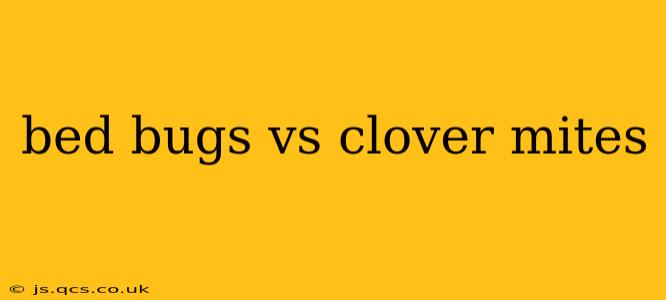Both bed bugs and clover mites are tiny pests that can invade homes, causing significant nuisance and, in some cases, health concerns. However, they are vastly different creatures with distinct characteristics, habitats, and behaviors. This comprehensive guide will help you differentiate between these two common household pests and understand how to best address infestations.
What are Bed Bugs?
Bed bugs ( Cimex lectularius) are parasitic insects that feed exclusively on the blood of humans and animals. They are small, oval-shaped, and reddish-brown in color. Adult bed bugs are about the size of an apple seed (4-5 mm). They are nocturnal creatures, emerging from their hiding places at night to feed. Bed bug bites often cause itchy welts, and infestations can cause significant stress and anxiety.
Identifying Bed Bugs: Key Characteristics
- Size: Approximately 4-5 mm long as adults.
- Color: Reddish-brown.
- Shape: Oval and flattened.
- Habitat: Hide in mattresses, box springs, bedding, cracks in walls, and furniture.
- Bites: Cause itchy welts, often in lines or clusters.
What are Clover Mites?
Clover mites (Bryobia praetiosa) are tiny arachnids, related to spiders and ticks, not insects like bed bugs. They are much smaller than bed bugs, often barely visible to the naked eye. They are typically red or reddish-orange and have eight legs, unlike the six-legged bed bug. Unlike bed bugs, they don’t bite or feed on human blood. Instead, they feed on plants, particularly clover, hence their name. They often invade homes in large numbers, particularly during dry periods or when their outdoor food sources dwindle.
Identifying Clover Mites: Key Characteristics
- Size: Much smaller than bed bugs, often less than 1 mm.
- Color: Red or reddish-orange.
- Legs: Eight legs (arachnid).
- Habitat: Often found near windows, doors, or other areas where they can enter from the outside.
- Bites: Do not bite humans. However, their presence can be irritating and alarming.
Bed Bugs vs. Clover Mites: A Side-by-Side Comparison
| Feature | Bed Bugs | Clover Mites |
|---|---|---|
| Type | Insect | Arachnid |
| Size | 4-5 mm | < 1 mm |
| Color | Reddish-brown | Red or reddish-orange |
| Legs | 6 | 8 |
| Feeding Habits | Feeds on human blood | Feeds on plants |
| Bites | Yes, itchy welts | No |
| Habitat | Mattresses, bedding, cracks in walls | Near windows, doors, exterior walls |
| Infestation | Localized, often in bedrooms | Can be widespread, often seasonal |
How to Tell the Difference: Visual Clues
The most significant difference is size and color. Bed bugs are considerably larger and reddish-brown, while clover mites are tiny and bright red or orange. Using a magnifying glass can help to distinguish the number of legs (six for bed bugs, eight for clover mites). Also, consider the location of the pests. Bed bugs are found closer to sleeping areas, while clover mites are more likely to be near entry points from the outside.
What to Do if You Suspect an Infestation
If you suspect a bed bug infestation, contact a qualified pest control professional immediately. Bed bug infestations require professional intervention for effective eradication. If you believe you have clover mites, you may be able to manage the infestation yourself by focusing on reducing their access points to your home, sealing cracks, and using a powerful vacuum to remove them. However, if the infestation is severe, professional help is still advisable.
Are Clover Mites Harmful?
While clover mites don't bite or spread disease, their sheer numbers can be disconcerting. Their presence inside a home can cause irritation to some individuals, particularly those with sensitive skin. Their small size and tendency to cluster can lead to skin irritation from contact. In some cases, severe infestations may lead to allergic reactions, but these are relatively uncommon.
This detailed comparison should help you accurately identify whether you're dealing with bed bugs or clover mites. Remember to consult with pest control professionals for infestations, especially if you're uncertain about the type of pest you are dealing with.
